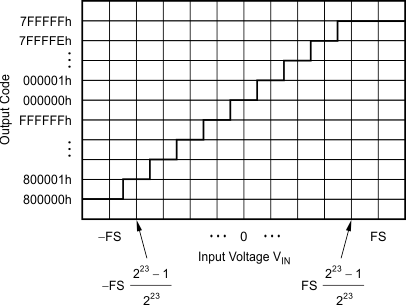ZHCSN81 july 2023 ADS131B23-Q1
PRODUCTION DATA
- 1
- 1 特性
- 2 应用
- 3 说明
- 4 Revision History
- 5 说明(续)
- 6 Pin Configuration and Functions
- 7 Specifications
- 8 Parameter Measurement Information
-
9 Detailed Description
- 9.1 Overview
- 9.2 Functional Block Diagram
- 9.3
Feature Description
- 9.3.1 Naming Conventions
- 9.3.2 Precision Voltage References (REFA, REFB)
- 9.3.3 Clocking (MCLK, OSCM, OSCD)
- 9.3.4 ADC1y
- 9.3.5 ADC2y
- 9.3.6 General-Purpose Digital Inputs and Outputs (GPIO0 to GPIO4)
- 9.3.7 General-Purpose Digital Inputs and Outputs (GPIO0A, GPIO1A, GPIO0B, GPIO1B)
- 9.3.8
Monitors and Diagnostics
- 9.3.8.1 Supply Monitors
- 9.3.8.2 Clock Monitors
- 9.3.8.3 Digital Monitors
- 9.3.8.4 Communication Monitors
- 9.3.8.5 Fault Flags and Fault Masking
- 9.3.8.6 FAULT Pin
- 9.3.8.7 Diagnostics and Diagnostic Procedure
- 9.3.8.8 Indicators
- 9.3.8.9 Conversion and Sequence Counters
- 9.3.8.10 Supply Voltage Readback
- 9.3.8.11 Temperature Sensor (TSA)
- 9.3.8.12 Test DACs (TDACA, TDACB)
- 9.3.8.13 Open-Wire Detection
- 9.3.8.14 Missing Host Detection and MHD Pin
- 9.3.8.15 Overcurrent Comparators (OCCA, OCCB)
- 9.4 Device Functional Modes
- 9.5
Programming
- 9.5.1
Serial Interface
- 9.5.1.1 Serial Interface Signals
- 9.5.1.2 Serial Interface Communication Structure
- 9.5.1
Serial Interface
- 9.6 Register Map
- 10Application and Implementation
- 11Device and Documentation Support
- 12Mechanical, Packaging, and Orderable Information
9.3.4.6 ADC1y Conversion Data
Conversion data for ADC1A and ADC1B are 24 bits and are automatically output on SDO as part of the SPI frame, unless register data are output following a register read command.
Data are provided in binary two's-complement format. Use Equation 8 to calculate the size of one code (LSB).
A positive full-scale input VIN ≥ +FSR – 1 LSB = VREFy / Gain – 1 LSB produces an output code of 7FFFFFh and a negative full-scale input (VIN ≤ –FSR = –VREFy / Gain) produces an output code of 800000h. The output clips at these codes for signals that exceed full-scale.
Table 9-7 summarizes the ideal output codes for different input signals.
| INPUT SIGNAL (VIN = VAINP – VAINN) |
IDEAL OUTPUT CODE |
|---|---|
| ≥ FSR (223 – 1) / 223 | 7FFFFFh |
| FSR / 223 | 000001h |
| 0 | 000000h |
| –FSR / 223 | FFFFFFh |
| ≤ –FSR | 800000h |
Figure 9-6 shows the mapping of the analog input signal to the output codes.
 Figure 9-6 Code
Transition Diagram (24-Bit Conversion Data)
Figure 9-6 Code
Transition Diagram (24-Bit Conversion Data)